1992 VOLKSWAGEN TRANSPORTER Page 97
[x] Cancel search: Page 97Page 122 of 164
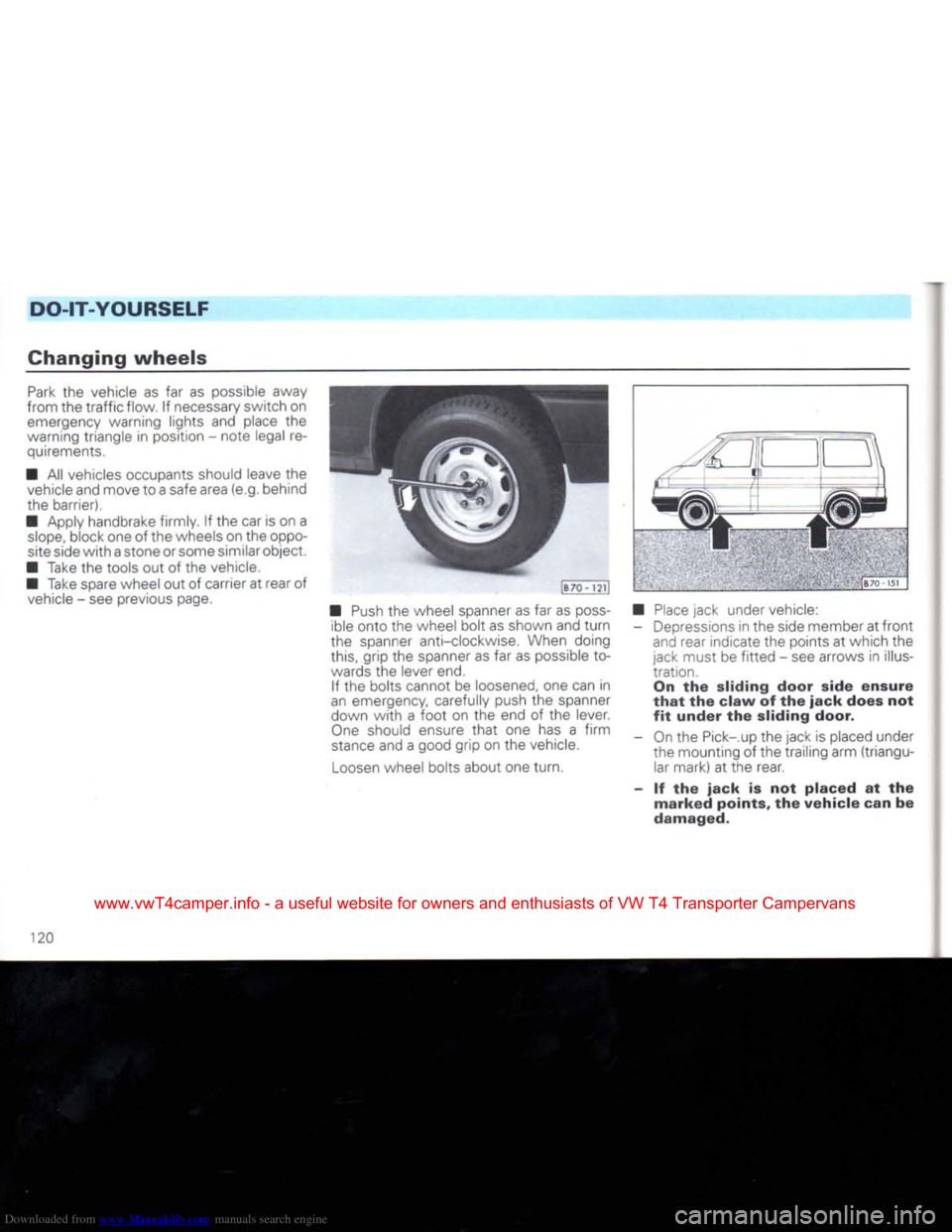
Downloaded from www.Manualslib.com manuals search engine
DO-IT-YOURSELF
Changing
wheels
Park
the vehicle as far as possible away
from the
traffic
flow, if necessary switch on emergency warning lights and place the
warning triangle in position - note legal re
quirements.
• All vehicles occupants should leave the vehicle and move to a safe area (e.g. behind
the barrier).
• Apply handbrake firmly. If the car is on a
slope,
block one of the wheels on the oppo
site side
with
a stone or some similar object.
• Take the tools out of the vehicle.
• Take spare wheel out of carrier at rear of vehicle - see previous page.
JB70
- 121J
•
Push
the wheel spanner as far as
poss
ible onto the wheel bolt as shown and
turn
the spanner anti-clockwise. When doing this, grip the spanner as far as possible to
wards the lever end.
If the bolts cannot be loosened, one can in
an emergency, carefully push the spanner
down
with
a
foot
on the end of the lever.
One
should ensure
that
one has a
firm
stance
and a good grip on the vehicle.
Loosen
wheel bolts about one turn. 8"" 1 •>!
•
Place
jack under vehicle: - Depressions in the side member at
front
and rear indicate the points at which the
jack must be
fitted
- see arrows in illus
tration. On the sliding door side
ensure
that
the
claw
of the
jack
does not
fit
under
the sliding door.
- On the Pick-.up the jack is placed under the mounting of the trailing arm (triangular mark) at the rear.
- If the
jack
is not
placed
at the
marked
points, the
vehicle
can be
damaged.
120
www.vwT4camper.info - a useful website for owners and enthusiasts of VW T4 Transporter Campervans
Page 123 of 164
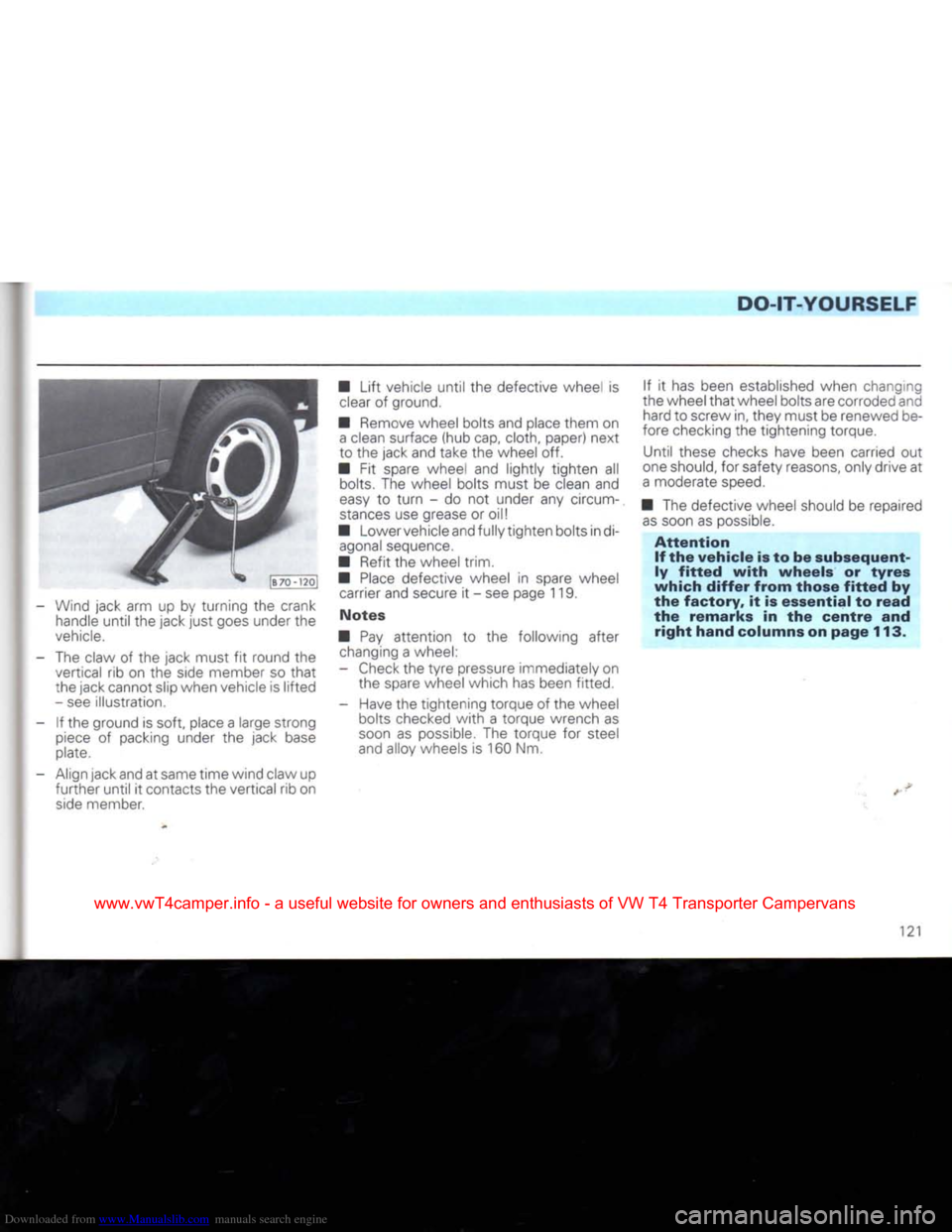
Downloaded from www.Manualslib.com manuals search engine
DO-IT-YOURSELF
- Wind jack arm up by turning the crank handle
until
the jack
just
goes under the
vehicle.
- The claw of the jack must fit round the vertical rib on the side member so
that
the jack cannot slip when vehicle is
lifted
- see illustration.
- If the ground is soft, place a large strong
piece
of packing under the jack base
plate.
- Align jack and at same time wind claw up
further
until
it contacts the vertical rib on
side
member. •
Lift
vehicle
until
the defective wheel is
clear
of ground.
• Remove wheel bolts and place them on
a
clean surface (hub cap, cloth, paper) next
to the jack and take the wheel off.
• Fit spare wheel and lightly tighten all bolts. The wheel bolts must be clean and
easy
to
turn
- do not under any circum
stances
use grease or oil!
• Lowervehicleand fully tighten bolts indi- agonal sequence.
• Refit the wheel trim.
•
Place
defective wheel in spare wheel carrier and secure it - see page 119.
Notes
• Pay attention to the following after changing a wheel:
- Check the
tyre
pressure immediately on the spare wheel which has been fitted.
- Have the tightening torque of the wheel bolts checked
with
a torque wrench as
soon
as possible. The torque for steel
and alloy wheels is 160 Nm. If it has been established when changing
the wheel
that
wheel bolts are corroded and hard to screw in, they must be renewed be
fore checking the tightening torque.
Until these checks have been carried out
one should, for safety reasons, only drive at
a
moderate
speed.
• The defective wheel should be repaired
as
soon as possible.
Attention
If the
vehicle
is to be
subsequent
ly
fitted
with
wheels
or
tyres
which
differ
from
those
fitted
by
the
factory,
it is
essential
to
read
the
remarks
in the
centre
and
right
hand
columns on
page
113.
121
www.vwT4camper.info - a useful website for owners and enthusiasts of VW T4 Transporter Campervans
Page 124 of 164

Downloaded from www.Manualslib.com manuals search engine
DO-IT-YOURSELF
Fuses
The
individual current circuits are protected by fuses..
The
central electrics
with
the relays is on
the
left
in the footwell behind a hinged shelf. It is advisable to always carry a few spare
fuses
on the vehicle. These can be obtained
from any Volkswagen dealer. Changing a fuse
• Switch off the component concerned. • Take box or lid off by turning knob 90 de
grees
to
right
or
left,
then pull and unhook box or lid out of retainers at the bottom.
• With the aid of the list of fuses (see next
page),
determine which fuse belongs to the
component
that
has failed. • Pull out the fuse concerned.
• Replace blown fuse - can be recognised
by the burnt metal strip -
with
a fuse of
same
amperage.
• Insert box or lid by turning knob again
905
to
right
or
left,
hook box or lid on at bot
tom, swing up and press knob in.
Notes
• If the newly inserted fuse blows again after a short time, the electrical system must be checked by
a
Volkswagen dealer as
soon
as possible.
• On no account should fuses be
patched
up because
this
can cause
serious
damage
elsewhere
in the
electrical
system.
• Some of the components listed are only found on certain models or are optional ex
tras.
122
www.vwT4camper.info - a useful website for owners and enthusiasts of VW T4 Transporter Campervans
Page 134 of 164
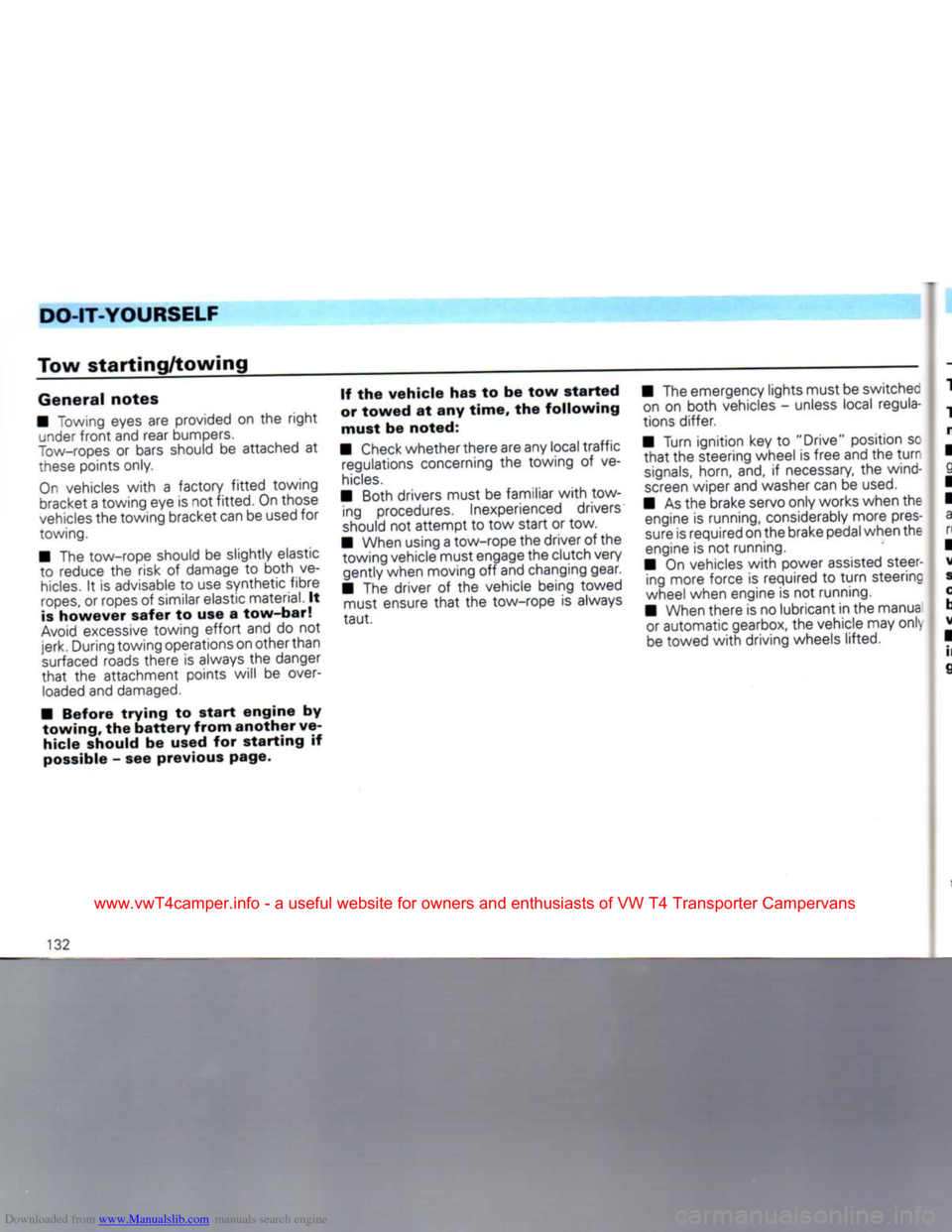
Downloaded from www.Manualslib.com manuals search engine
DO-IT-YOURSELF
Tow
starting/towing
General
notes
• "owing eyes are provided on the
right
under
front
and rear bumpers.
Tow-ropes
or bars should be attached at
these
points only.
On
vehicles
with
a factory
fitted
towing bracket a towing eye is not fitted. On those
vehicles
the towing bracket can be used for
towing.
• The tow-rope should be slightly elastic to reduce the risk of damage to both ve
hicles.
It is advisable to use synthetic fibre
ropes,
or ropes of similar elastic material. It
is
however
safer
to use a
tow-bar!
Avoid
excessive towing
effort
and do not
jerk.
During towing operations on other than
surfaced
roads there is always the danger
that
the attachment points will be over
loaded
and damaged.
•
Before
trying
to
start
engine
by
towing,
the
battery
from
another
ve
hicle
should be used for
starting
if
possible - see previous page. If the
vehicle
has to be tow
started
or
towed
at any
time,
the
following
must
be noted:
•
Check
whether there are any local traffic regulations concerning the towing of ve
hicles.
• Both drivers must be familiar
with
tow ing procedures. Inexperienced drivers
should
not attempt to tow start or tow.
• When using a tow-rope the driver of the towing vehicle must engage the clutch very gently when moving off and changing gear.
• The driver of the vehicle being towed must ensure
that
the tow-rope is always
taut.
• The emergency lights must be switchec
on on both vehicles - unless local regula
tions differ.
• Turn ignition key to "Drive" position sc
that
the steering wheel is free and the
turr
signals,
horn, and, if necessary, the wind
screen
wiper and washer can be
used.
• As the brake servo only works when the engine is running, considerably more pres
sure
is required on the brake pedal when the
engine is not running.
• On vehicles
with
power assisted steer ing more force is required to
turn
steering
wheel when engine is not running.
• When there is no lubricant in the manua or automatic gearbox, the vehicle may only
be
towed
with
driving wheels lifted.
132
www.vwT4camper.info - a useful website for owners and enthusiasts of VW T4 Transporter Campervans
Page 135 of 164
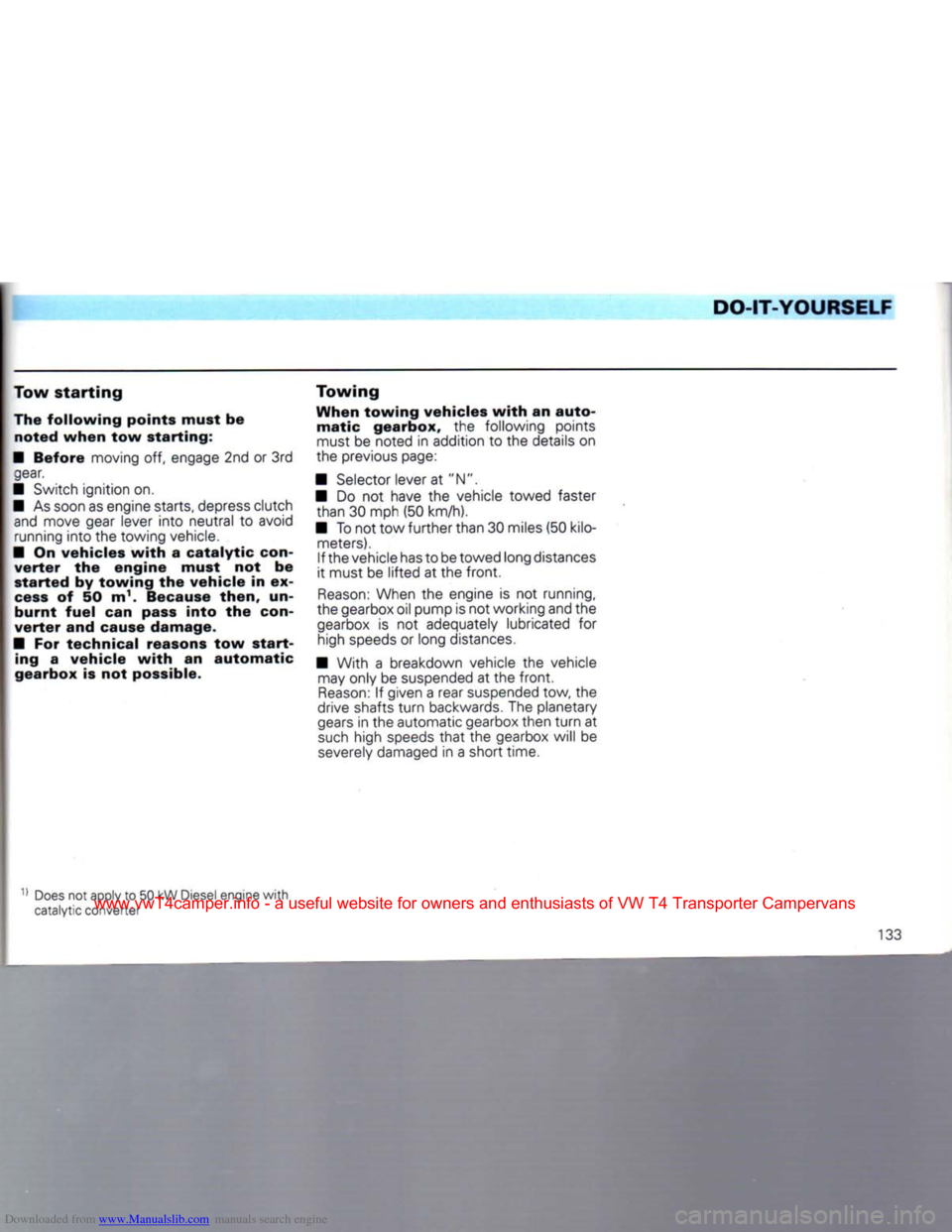
Downloaded from www.Manualslib.com manuals search engine
DO-IT-YOURSELF
Tow
starting
The
following
points
must
be
noted
when
tow
starting:
•
Before
moving off, engage 2nd or 3rd gear.
• Switch ignition on.
• As soon as engine starts, depress clutch and move gear lever
into
neutral to avoid running
into
the towing vehicle.
• On
vehicles
with
a
catalytic
con
verter
the
engine
must
not be
started
by
towing
the
vehicle
in ex
cess of 50 m1. Because
then,
un-
burnt
fuel
can pass
into
the con
verter
and cause
damage.
• For
technical
reasons tow
start
ing a
vehicle
with
an
automatic
gearbox
is not possible.
Towing
When
towing
vehicles
with
an
auto
matic
gearbox,
the following points must be noted in addition to the details on
the previous page:
• Selector lever at "N".
• Do not have the vehicle towed faster than 30 mph (50 km/h).
• To not tow
further
than 30 miles (50 kilo meters). If the vehicle has to be towed long distances
it must be
lifted
at the
front.
Reason:
When the engine is not running,
the gearbox oil pump is not working and the
gearbox is not adequately lubricated for high speeds or long distances.
• With a breakdown vehicle the vehicle may only be suspended at the
front.
Reason:
If given a rear suspended tow, the
drive shafts
turn
backwards. The planetary
gears
in the automatic gearbox then
turn
at
such
high speeds
that
the gearbox will be
severely
damaged in a short time.
Does
not apply to 50 kW Diesel engine
with
catalytic converter
133
www.vwT4camper.info - a useful website for owners and enthusiasts of VW T4 Transporter Campervans
Page 137 of 164
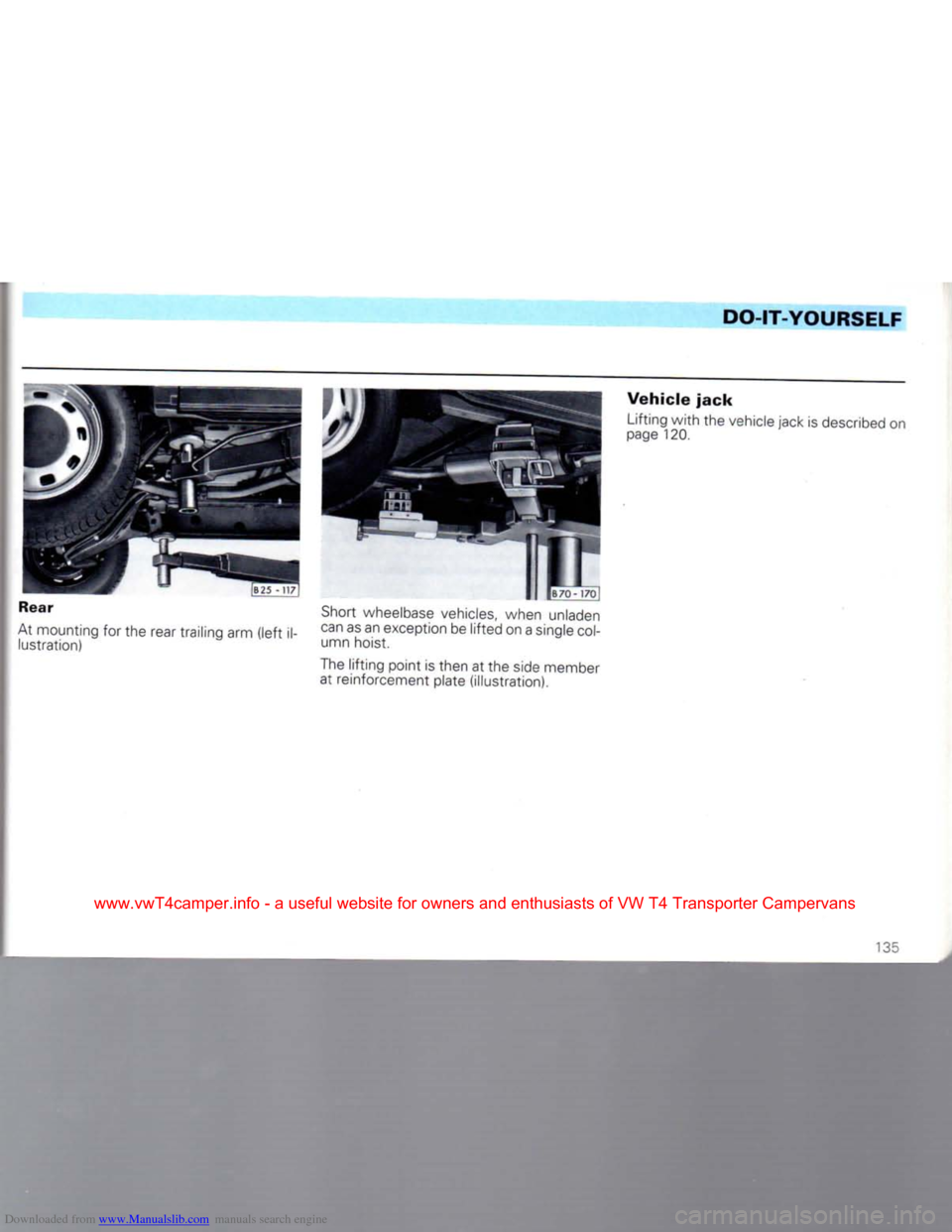
Downloaded from www.Manualslib.com manuals search engine
DO-IT-YOURSELF
Rear
At mounting for the rear trailing arm (left i lustration) Short wheelbase vehicles, when unladen
can as an exception be lifted on a single
col
umn hoist.
The lifting point is then at the side member at reinforcement plate (illustration).
Vehicle
jack
Lifting with the vehicle jack is described on
page 120.
135
www.vwT4camper.info - a useful website for owners and enthusiasts of VW T4 Transporter Campervans
Page 139 of 164
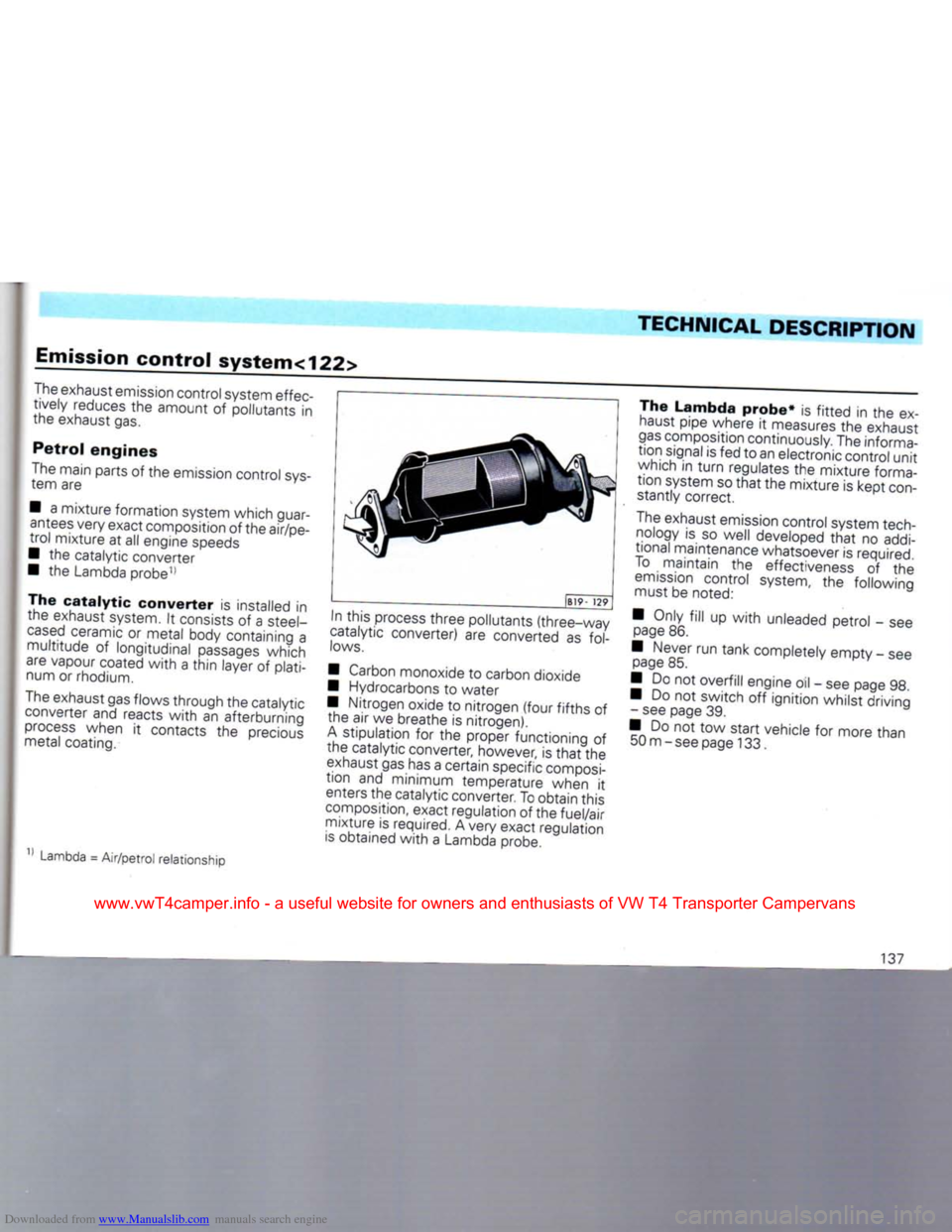
Downloaded from www.Manualslib.com manuals search engine
TECHNICAL
DESCRIPTION
Emission
control
system<122>
The exhaust emission control system effec
tively reduces
the
amount
of
pollutants
in
the exhaust gas.
Petrol
engines
The main parts
of the
emission control
sys
tem
are
•
a
mixture formation system which guar antees very exact composition
of
the air/pe
trol
mixture
at all
engine speeds
•
the
catalytic converter
•
the
Lambda probe1'
The
catalytic
converter
is
installed
in
the exhaust system.
It
consists
of a
steel-
cased
ceramic
or
metal body containing
a
multitude
of
longitudinal
passages
which
are vapour coated
with
a
thin
layer
of
plati
num
or
rhodium.
The exhaust gas flows through
the
catalytic converter
and
reacts
with
an
afterburning
process
when
it
contacts
the
precious
metal coating.
Lambda
=
Air/petrol relationship
)B19-
129
In
this process three pollutants (three-way
catalytic converter)
are
converted
as
fol
lows.
• Carbon monoxide
to
carbon dioxide
• Hydrocarbons
to
water
• Nitrogen oxide
to
nitrogen
(four
fifths
of
the
air we
breathe
is
nitrogen).
A
stipulation
for the
proper functioning
of
the catalytic converter, however,
is
that
the
exhaust gas has
a
certain specific composi
tion
and
minimum temperature when
it
enters
the
catalytic converter. To obtain this
composition, exact regulation
of the
fuel/air mixture
is
required. Avery exact regulation
is
obtained
with
a
Lambda probe. The Lambda
probe*
is
fitted
in the ex
haust pipe where
it
measures
the
exhaust
gas
composition continuously. The informa
tion
signal
is
fed
to
an electronic control
unit
which
in
turn
regulates
the
mixture forma
tion
system so
that
the
mixture
is
kept
con
stantly correct.
The exhaust emission control system tech nology
is so
well developed
that
no
addi
tional maintenance whatsoever
is
required.
To
maintain
the
effectiveness
of the
emission
control system,
the
following
must
be
noted:
• Only
fill
up
with
unleaded petrol
- see
page
86.
• Never
run
tank completely empty
-
see page
85.
•
Do not
overfill engine
oil -
see page
98.
•
Do not
switch
off
ignition whilst driving - see page
39.
•
Do not tow
start vehicle
for
more than 50 m-see page 133.
137
www.vwT4camper.info - a useful website for owners and enthusiasts of VW T4 Transporter Campervans
Page 143 of 164
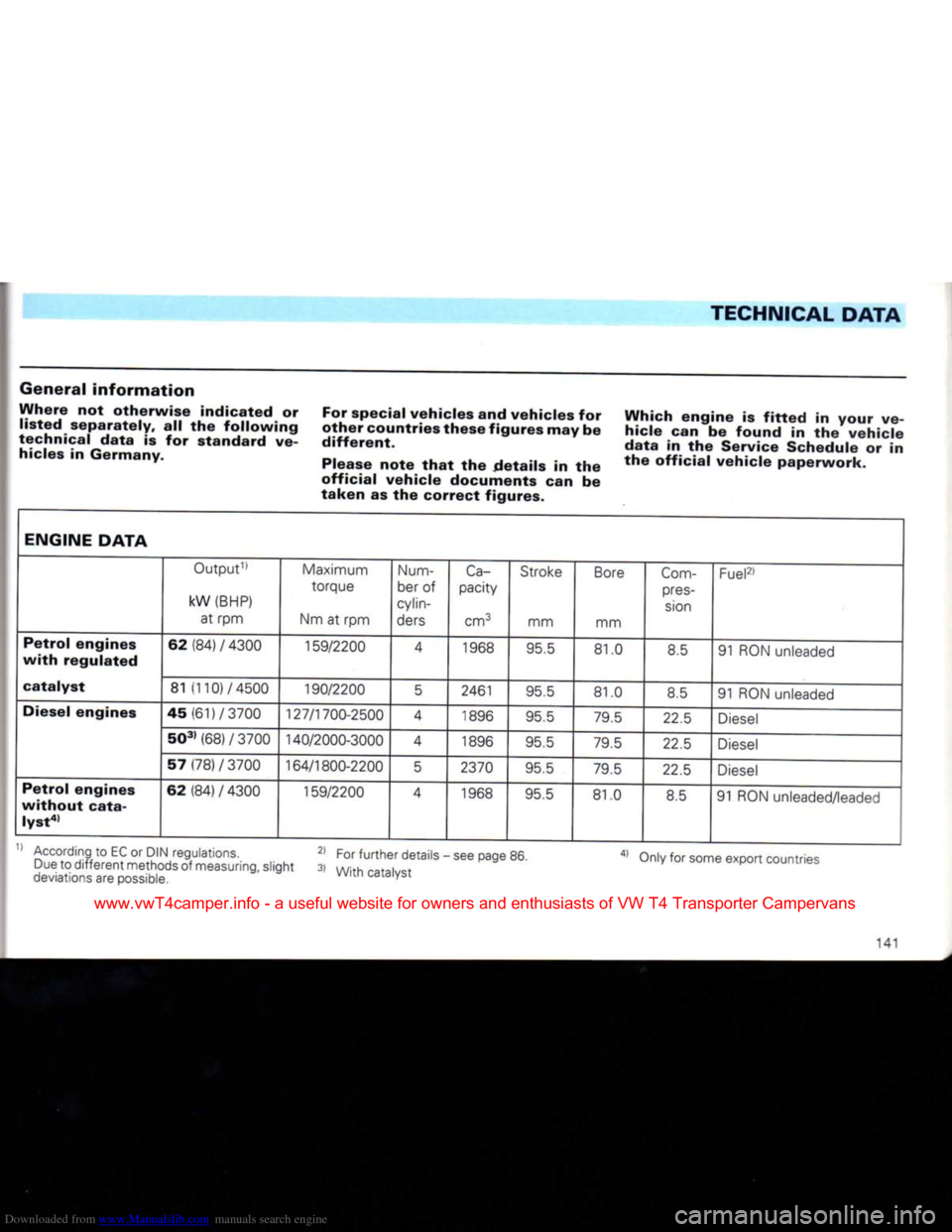
Downloaded from www.Manualslib.com manuals search engine
TECHNICAL DATA
General information
Where
not
otherwise indicated
or
listed separately,
all the
following
technical data
is for
standard
ve
hicles
in
Germany. For special vehicles
and
vehicles
for
other countries these figures
may be
different.
Please note that
the
details
in the
official vehicle documents
can be
taken
as the
correct figures. Which engine
is
fitted
in
your
ve
hicle
can be
found
in the
vehicle
data
in the
Service Schedule
or in
the official vehicle paperwork.
ENGINE DATA
Output11
kW
(BHP)
at
rpm
Maximum
torque
Nm
at rpm
Num
ber
of
cylin
ders
Ca
pacity
cm3
Stroke
mm
Bore
mm
Com
pres
sion
Fuel2'
Petrol engines
with regulated
catalyst 62 (84)
/
4300
159/2200
4
1968
95.5
81.0
8.5
91
RON
unleaded
Petrol engines
with regulated
catalyst
81
(110)/4500
190/2200
5
2461
95.5
81.0
8.5
91
RON
unleaded
Diesel engines 45 (61)/3700
127/1700-2500
4
1896
95.5 79.5
22.5
Diesel
Diesel engines
503>
(68)
/
3700
140/2000-3000
4
1896
95.5 79.5
22.5
Diesel
Diesel engines
57 (78)/3700
164/1800-2200
5
2370
95.5
79.5 22.5
Diesel
Petrol engines
without cata
lyst41
62 (84)
/
4300
1 59/2200 4
1968
95.5
81.0
8.5
91
RON
unleaded/leaded
11 According to EC or DIN regulations. Due to different methods of measuring, slight
deviations are possible. 21 For further details -
31 With catalyst see page 86.
4) Only for some export countries
141
www.vwT4camper.info - a useful website for owners and enthusiasts of VW T4 Transporter Campervans